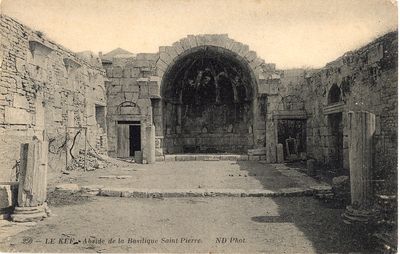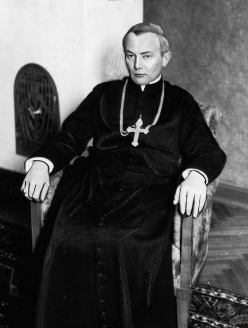|
Sicca Veneria (episcopal See)
The Diocese of Sicca Veneria was an episcopal see of Africa Proconsularis, and was a suffragan of the bishops of Carthage. The cathedra of the bishopric was in the Roman colonia (highest ranking city) of Colonia Julia Veneria Cirta Nova Iulia. The bishopric was founded in early Christianity; it ceased to function sometime after the Muslim conquest of the Maghreb. It exists today as a titular see of the Roman Catholic Church. The current bishop is Lajos Varga of Hungary. Remains of the bishopric included ruins at El Kef of a cathedral, baptistry, Christian burials, and numerous Christian inscriptions. Known bishops Antiquity and Early Middle Ages *Castus, at the Council of Carthage (255), at which he addressed the meeting *Patritius mentioned in 349; *Fortunatianus mentioned in 407, present at the Council of Carthage (411) and spoken of by St. Augustine, *Urbanus in 418, mentioned in 429 by Augustine, *Paul towards 480; *Candidus in 646. Catholic Kazimierz Tomczak ... [...More Info...] [...Related Items...] OR: [Wikipedia] [Google] [Baidu] |
Hungary
Hungary ( hu, Magyarország ) is a landlocked country in Central Europe. Spanning of the Carpathian Basin, it is bordered by Slovakia to the north, Ukraine to the northeast, Romania to the east and southeast, Serbia to the south, Croatia and Slovenia to the southwest, and Austria to the west. Hungary has a population of nearly 9 million, mostly ethnic Hungarians and a significant Romani minority. Hungarian, the official language, is the world's most widely spoken Uralic language and among the few non- Indo-European languages widely spoken in Europe. Budapest is the country's capital and largest city; other major urban areas include Debrecen, Szeged, Miskolc, Pécs, and Győr. The territory of present-day Hungary has for centuries been a crossroads for various peoples, including Celts, Romans, Germanic tribes, Huns, West Slavs and the Avars. The foundation of the Hungarian state was established in the late 9th century AD with the conquest of the Carpat ... [...More Info...] [...Related Items...] OR: [Wikipedia] [Google] [Baidu] |
Bishop Of Łódź
A bishop is an ordained clergy member who is entrusted with a position of authority and oversight in a religious institution. In Christianity, bishops are normally responsible for the governance of dioceses. The role or office of bishop is called episcopacy. Organizationally, several Christian denominations utilize ecclesiastical structures that call for the position of bishops, while other denominations have dispensed with this office, seeing it as a symbol of power. Bishops have also exercised political authority. Traditionally, bishops claim apostolic succession, a direct historical lineage dating back to the original Twelve Apostles or Saint Paul. The bishops are by doctrine understood as those who possess the full priesthood given by Jesus Christ, and therefore may ordain other clergy, including other bishops. A person ordained as a deacon, priest (i.e. presbyter), and then bishop is understood to hold the fullness of the ministerial priesthood, given responsibility b ... [...More Info...] [...Related Items...] OR: [Wikipedia] [Google] [Baidu] |
Poznań
Poznań () is a city on the River Warta in west-central Poland, within the Greater Poland region. The city is an important cultural and business centre, and one of Poland's most populous regions with many regional customs such as Saint John's Fair (''Jarmark Świętojański''), traditional Saint Martin's croissants and a local dialect. Among its most important heritage sites are the Renaissance Old Town, Town Hall and Gothic Cathedral. Poznań is the fifth-largest and one of the oldest cities in Poland. As of 2021, the city's population is 529,410, while the Poznań metropolitan area (''Metropolia Poznań'') comprising Poznań County and several other communities is inhabited by over 1.1 million people. It is one of four historical capitals of medieval Poland and the ancient capital of the Greater Poland region, currently the administrative capital of the province called Greater Poland Voivodeship. Poznań is a center of trade, sports, education, technology an ... [...More Info...] [...Related Items...] OR: [Wikipedia] [Google] [Baidu] |
Bishop Of Gniezno
This is a list of archbishops of the Archdiocese of Gniezno, who are simultaneously primates of Poland since 1418."Archdiocese of Gniezno" ''''. David M. Cheney. Retrieved February 29, 2016"Metropolitan Archdiocese of Gniezno" ''GCatholic.org''. Gabriel Chow. Retrieved February 29, 2016 They also served as '''' in the |
Stanislaw Kostka Łukomski
Stanislaw Kostka Łukomski (21 October 1874 – 4 November 1948) was a leading Polish bishop and right-wing political activist. He died in suspicious circumstances shortly after World War II. He was born in the village of in Sadki parish of the Archdiocese of Gniezno on October 21, 1874. On February 24, 1898, was ordained a priest. Łukomski became a member of the National league in 1900. On March 8, 1920, he was appointed auxiliary bishop of Archdiocese of Sicca Veneria. After the death of Cardinal Edmund Dalbor in 1926, he managed the Archdiocese as Vicar Capitular for a short time. On 29 December 1921, he was awarded the Commander's Cross of the Order of Polonia Restituta. On June 24, 1926, was made bishop of the Diocese of Łomża, where he coordinated the work of the diocesan Catholic Action group and contributed to the expansion of the cathedral. 1926 also saw him serve as secretary of the Polish Episcopal Conference. He resigned from this role in 1936, but his resi ... [...More Info...] [...Related Items...] OR: [Wikipedia] [Google] [Baidu] |
Gustave Marie Blanche
Gustav, Gustaf or Gustave may refer to: *Gustav (name), a male given name of Old Swedish origin Art, entertainment, and media * ''Primeval'' (film), a 2007 American horror film * ''Gustav'' (film series), a Hungarian series of animated short cartoons * Gustav (''Zoids''), a transportation mecha in the ''Zoids'' fictional universe *Gustav, a character in '' Sesamstraße'' *Monsieur Gustav H., a leading character in ''The Grand Budapest Hotel'' Weapons *Carl Gustav recoilless rifle, dubbed "the Gustav" by US soldiers * Schwerer Gustav, 800-mm German siege cannon used during World War II Other uses * Gustav (pigeon), a pigeon of the RAF pigeon service in WWII * Gustave (crocodile), a large male Nile crocodile in Burundi *Gustave, South Dakota *Hurricane Gustav (other), a name used for several tropical cyclones and storms *Gustav, a streetwear clothing brand See also *Gustav of Sweden (other) *Gustav Adolf (other) *Gustave Eiffel (other) * * *Gust ... [...More Info...] [...Related Items...] OR: [Wikipedia] [Google] [Baidu] |
Kazimierz Tomczak
Kazimierz Tomczak (1883–1967) was a 20th-century Polish bishop theologian and teacher, interned by the Nazi forces during World War II. He was born on 17 February 1883 in Besiekierzu and studied at the Jesuit School in Chyrów, where he graduated from high school. He studied also at the Saint Petersburg Roman Catholic Theological Academy, in Paris, and in Freiburg, and was ordained a priest on 7 January 1907. For 16 years he worked as a professor at the , where he taught moral theology, the history of philosophy, archaeology, Christian liturgy and literature. In 1936, he was one of the founders of the Society of Friends of Science in Łódź. On 25 February 1927, Pope Pius XII appointed him the first auxiliary bishop of the diocese of Łódź and titular bishop of Sicca Veneria. He was ordained bishop on 3 April 1927 in Warsaw Cathedral by cardinal Aleksander Kakowski. On 6 September 1939, after the Invasion of Poland, he headed the Citizens' Committee of Łódź with the ... [...More Info...] [...Related Items...] OR: [Wikipedia] [Google] [Baidu] |
Augustine Of Hippo
Augustine of Hippo ( , ; la, Aurelius Augustinus Hipponensis; 13 November 354 – 28 August 430), also known as Saint Augustine, was a theologian and philosopher of Berber origin and the bishop of Hippo Regius in Numidia, Roman North Africa. His writings influenced the development of Western philosophy and Western Christianity, and he is viewed as one of the most important Church Fathers of the Latin Church in the Patristic Period. His many important works include '' The City of God'', '' On Christian Doctrine'', and '' Confessions''. According to his contemporary, Jerome, Augustine "established anew the ancient Faith". In his youth he was drawn to the eclectic Manichaean faith, and later to the Hellenistic philosophy of Neoplatonism. After his conversion to Christianity and baptism in 386, Augustine developed his own approach to philosophy and theology, accommodating a variety of methods and perspectives. Believing the grace of Christ was indispensable to human fr ... [...More Info...] [...Related Items...] OR: [Wikipedia] [Google] [Baidu] |
Council Of Carthage (411)
The Councils of Carthage were church synods held during the 3rd, 4th, and 5th centuries in the city of Carthage in Africa. The most important of these are described below. Synod of 251 In May 251 a synod, assembled under the presidency of Cyprian to consider the treatment of the Lapsi, excommunicated Felicissimus and five other Novatian bishops (Rigorists), and declared that the lapsi should be dealt with, not with indiscriminate severity, but according to the degree of individual guilt. These decisions were confirmed by a synod of Rome in the autumn of the same year. Other Carthaginian synods concerning the lapsi were held in 252 and 254. Synod of 256 Two synods, in 255 and 256, held under Cyprian, pronounced against the validity of heretical baptism, thus taking direct issue with Stephen I, bishop of Rome, who promptly repudiated them. A third synod in September 256, possibly following the repudiation, unanimously reaffirmed the position of the other two. Stephen's claims to au ... [...More Info...] [...Related Items...] OR: [Wikipedia] [Google] [Baidu] |
Council Of Carthage (255)
A council is a group of people who come together to consult, deliberate, or make decisions. A council may function as a legislature, especially at a town, city or county/shire level, but most legislative bodies at the state/provincial or national level are not considered councils. At such levels, there may be no separate executive branch, and the council may effectively represent the entire government. A board of directors might also be denoted as a council. A committee might also be denoted as a council, though a committee is generally a subordinate body composed of members of a larger body, while a council may not be. Because many schools have a student council, the council is the form of governance with which many people are likely to have their first experience as electors or participants. A member of a council may be referred to as a councillor or councilperson, or by the gender-specific titles of councilman and councilwoman. In politics Notable examples of types of ... [...More Info...] [...Related Items...] OR: [Wikipedia] [Google] [Baidu] |
Map Of Roman Africa Proconsularae
A map is a symbolic depiction emphasizing relationships between elements of some space, such as objects, regions, or themes. Many maps are static, fixed to paper or some other durable medium, while others are dynamic or interactive. Although most commonly used to depict geography, maps may represent any space, real or fictional, without regard to context or scale, such as in brain mapping, DNA mapping, or computer network topology mapping. The space being mapped may be two dimensional, such as the surface of the earth, three dimensional, such as the interior of the earth, or even more abstract spaces of any dimension, such as arise in modeling phenomena having many independent variables. Although the earliest maps known are of the heavens, geographic maps of territory have a very long tradition and exist from ancient times. The word "map" comes from the , wherein ''mappa'' meant 'napkin' or 'cloth' and ''mundi'' 'the world'. Thus, "map" became a shortened term referring to ... [...More Info...] [...Related Items...] OR: [Wikipedia] [Google] [Baidu] |


.jpg)


